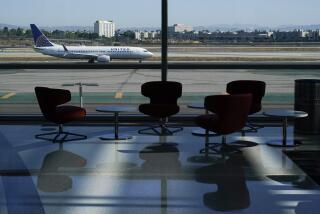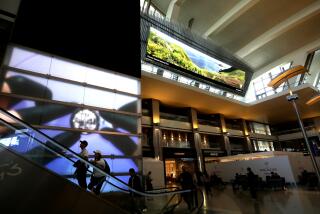Airport opens massive gateway to new China
BEIJING — It’s a huge building, much bigger than the Pentagon and a whole lot less clunky. It’s expected to handle more passengers than any other air terminal in the world. It was built fast.
Beijing’s new international air terminal, which opened today in time for the Summer Olympics surge, attracts and embodies superlatives. It also embodies the new China, a country racing headlong into the future fueled by an economy on fire.
The airy glass-and-steel structure, even at two miles long and half a mile wide, raced from design to takeoff in four years. Most airport projects take a decade or more to complete and usually involve lengthy reviews, detailed assessments, planning committees, public hearings and environmental impact statements.
As a band played “Auld Lang Syne,” and officials cut red ribbons and gave speeches, passengers delivered their verdict this morning.
“I think it’s beautiful and brilliant and I’m very proud for China,” said Ou Min, a 26-year-old banker, booked on one of the terminal’s first departing flights to London.
“And the design, the sun, the space, it really makes you feel free,” she added.
Security guards smiled and cheerful staffers directed customers, in a country where service is not always second nature.
For many countries increasingly worried about how competitive and fast-moving China is, this $2.8-billion project provides one more reason to fret. China’s authoritarian system can certainly move. At its peak, the construction site had 50,000 workers toiling around the clock.
Elsewhere across China, skyscrapers sprout, highways unfurl and dams appear at breakneck speed, cutting through neighborhoods and displacing millions of people in the process. This terminal is among about $40 billion worth of projects being built in Beijing alone in advance of the Games, which start Aug. 8.
“Most Western politicians wouldn’t admit agreeing to that system, but they’re very jealous,” said Rory McGowan, Beijing-based director of global engineering firm Ove Arup & Partners, which worked on the project. The Chinese “can react to decisions four or five times faster than we can [in the West] because China runs the way it does.” China has a long history of awing visitors with structures that evoke size and power, epitomized by the Forbidden City.
The new Terminal 3 at Beijing Capital International Airport is a modern counterpart, the gateway to a new China.
“This is the front door of China,” said Brian Timmoney, Beijing-based partner with London architect Norman Foster.
Designed by Foster and the Beijing Architectural Design & Research Institute, the terminal measures about 10.6 million square feet. By comparison, the Pentagon, often described as the largest office building in the world, is 6.5 million square feet. And the enormous terminal is astride a runway able to handle the new Airbus A380 superjumbo jets. It’s got all manner of bells and whistles, including “barrier-free” facilities for the disabled, floor tracking to guide the blind, and multi-denominational prayer rooms in an officially atheist country. It also has baby-changing facilities galore and 26 smoking rooms with advanced filtering systems -- in short, a lot of stuff you probably won’t see again during your stay in China.
The designers put a premium on air, light, greenery and distinct Chinese characteristics. The sloping roof is meant to evoke a dragon, with triangular skylights resembling scales. Feng shui principles were incorporated into the design, and the interior is decorated in colors that hold special meaning for Chinese.
“Feng shui has a scientific and a superstitious side,” said Shao Weiping, principal architect with Beijing Architectural Design. “We used the scientific side.”
Passengers entering the terminal are met with a blaze of red, evoking celebration, good luck, joy and enthusiasm. By the time you approach your gate more than a mile distant, preferably using an automated train, the interior has shaded to yellow. This color is associated with royalty, mother and earth, which presumably act as a calming influence.
At Los Angeles International Airport, where some modernization projects are underway, city leaders have spent years seeking a politically acceptable upgrade plan.
Six airlines will start flying from Beijing’s massive terminal today, and flag carrier Air China and others will move from the airport’s two older terminals in March. Air China and United are the only airlines offering nonstop service from Beijing to LAX. United’s flights will also move to the new terminal next month.
China’s air traffic has skyrocketed as its increasingly affluent citizens are allowed to travel, even as the world flocks to its doors.
The new terminal will boost the airport’s annual capacity by tens of millions of passengers to 82 million, a target planners originally expected to hit around 2015, but now believe could come years earlier. A second international airport is already under consideration.
The region’s competitive equation is expected to be altered by the new terminal. It will allow China to handle more of its own passenger and freight traffic, which has overflowed its borders to the benefit of new airports in Singapore, South Korea, Japan and Hong Kong.
Beijing also will be able to negotiate more nonstop services with North American hubs, as San Francisco, Seattle, Houston and Dallas seek a bigger share of the trans-Pacific market.
The terminal was built in modules with many systems prefabricated to ensure reliability, although builders acknowledge privately that work quality is always a concern.
The rapid expansion of China’s aviation system has led to safety concerns. China has had no major accidents in the last three years, but previously had suffered several that were attributed in part to rapid growth.
“It’s a big issue,” said Leithen Francis, Singapore-based deputy Asia editor with Flight International, a trade magazine. “They may have millions of workers, but when it comes to skilled maintenance engineers, air-traffic controllers and pilots, they’re experiencing shortages.”
The danger, experts say, is that workers get promoted too quickly without gaining years of experience. Recently departed Chinese civil aviation minister Yang Yuanyuan made safety a priority, including the introduction of a “no blame” system for workers who pointed out problems. But it remains to be seen whether his successor, Li Jiaxiang, will follow suit.
Airport planners hope their facility’s $250-million state-of-the-art luggage-handling system won’t suffer the problems seen when Denver and Hong Kong opened their airports in the 1990s. Issues included malfunctioning computers and derailing baggage trains.
But as the airport opened, passengers were more impressed than worried.
“It’s all shocking, in a great way,” said Tang Yi, 24, a passenger in the food service industry rushing for a domestic flight, his wheeled luggage in tow. “And it sure is huge.”
--
Wu Yuxiu in The Times’ Beijing Bureau contributed to this report.
More to Read
Sign up for Essential California
The most important California stories and recommendations in your inbox every morning.
You may occasionally receive promotional content from the Los Angeles Times.










